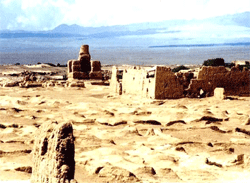|
 Jiaohe
Town ruin is the best preserved town ruin in China. It is located
about 10 kilometers away from Turpan city. The strip-shaped town
was around 0.8 kilometers long and the widest point spanned about
300 meters. The town was surrounded by sheer cliffs, then two
twisting 30-meter-deep rivers. That's why the town was so called
for Jiaohe means twisting rivers in Chinese. Jiaohe
Town ruin is the best preserved town ruin in China. It is located
about 10 kilometers away from Turpan city. The strip-shaped town
was around 0.8 kilometers long and the widest point spanned about
300 meters. The town was surrounded by sheer cliffs, then two
twisting 30-meter-deep rivers. That's why the town was so called
for Jiaohe means twisting rivers in Chinese.
Hejiao's history can trace back to late Stone Age. Ancient residents
built their homes in a lagoon island to protect against attack
from wild animals and invasions from other tribes. They dug out
dwelling caves out from the tough loess and chiseled passages
to lead water from the rivers to the town. Visitors can still
find some remnants of the simple tools including scraping tools,stone
slates and colored pottery ware pieces on the ground close to
the town ruin. These early residents belonged to the Gushi tribe,
who was called Cheshi tribe in the subsequent dynasties. During
the Warrior States Period, tribes on the south side of the Tainshan
Mountain set up their own kingdoms successively. The area around
Jiaohe was controlled by the Cheshi People who took advantage
of the ideal geographical location of the region and made it their
power seat. According to historical documents, Cheshi People live
in tents and did farming. They raised cattle, camels, ship and
other livestock.
Jiaohe played an important military role in China's history.
Jiaohe's vital location for trade and military made it especially
vulnerable for invasion and attack. Dynasties in central China
and nomadic tribes in north China fight bitterly for it. Jiaohe
was recognizably territory of the Han Dynasty in 67 AD. The Han
rulers set up administration office in the area to rule over the
Kingdoms in the Western Region.
Jiaohe area was controlled by Tuque after the Han Dynasty. The great Yang Dynasty defeated the Tuque and took the region. Jiaohe county was later set up and it was under the jurisdiction of West Zhou. Jiaohe was afterward became the military and political center of the Western Region of the Tang Dynasty.
Turpan was gained by the Tubo tribe during the period from middle eight century to the nine century. The Tubo set up Jiaohe County here and it was one of the most important military towns. However, the government policy resulted in the decline of that town since ever.
Jiaohe was completely destroyed by wars in the 14th century. Evidences indicate that the places became a ruin as early as the Ming Dynasty.
In the ruin, there are 1389 residential house ruins, 53 Buddhism temples, 316 ancient wells and 34 alleys. The town was uniquely arranged, containing an above part and a underground part.
There were originally 3 gates to the town: the south, east and west gates. The South Gate was the mainly used for military purpose. The West Gate which was abandoned much earlier left very little evidence to piece together its original looks. But, historical documents display the dominant role it played. It was said that when the Han troops returned after defeated the Xiongnu, civilian and officials gathered at the gate celebrating victory over enemy.
The main street of Jiaohe Town ran from south to north, about 350 meters long and 10 meters wide. The street cut the town into two sections. The populous east section with dense buildings was the official area and the west section, characterized by sporadic dilapidated buildings was residential and workshop area.
The west section had 2,0000 square meter with main and attached buildings and squares. The grandest building complex in this part was the palaces of former Cheshi State. Crisscrossed streets and underground passages and gardens are visible in the ruin.
Buildings at the residential area are well preserved. The houses were mainly in cave-style created by digging into the ground. Each house is attached with a garden, inside which lied a deep well.
In the north side stood many Buddhism Temples. Jiaohe was once
China's Buddhism center. Buddhism spread from Indian through the
Western Region to inland provinces of China and it's was flourished
at the Western Region on its way. Western Region thus renowned as
the Second Hometown of Buddhism. |